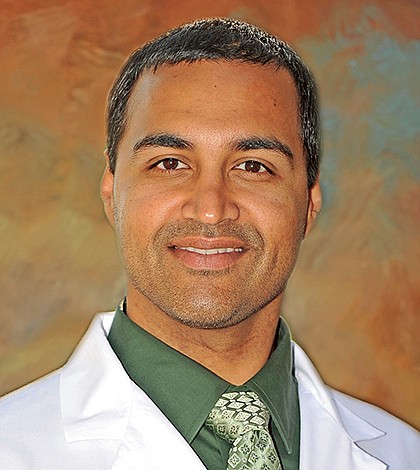- July 26, 2024
-
-
Loading

Loading

Although often thought of as the closest thing to a male equivalent of breast cancer, prostate cancer and similar diseases act much differently, Dr. Faseeh Khaja said.
Khaja, a member of the UF Health Cancer Center at Health Central Hospital in Ocoee, says prostate cancer is a disease of age most often found in elderly men. This can make diagnosing the disease difficult, because many already show the danger signs of it, such as urinary frequency and incontinence.
“In terms of things to look out for, there’s not really much to look out for,” Khaja says. “Usually, our patients detect their prostate cancer based on … something their primary-care doctor would do. Sometimes, they’ll have bone pains, so it’s actually a tricky disease to handle in terms of the initial diagnosis.”
Other than cancer, the prostate disease doctors watch for is benign prostatic hyperplasia, an enlargement of the prostate.
“Usually, it’s about the size of a walnut when you’re in your 30s and 40s, but as you get older, it gets enlarged, and it can squeeze down on the urethra, where urine comes from, and basically makes it more difficult for you to pee,” he says. “That disorder and prostate cancer kind of have the same symptoms.”
Treatment for prostate disorders has improved significantly since the 1990s, when hormone deprivation was the only option, Khaja says.
“In the ‘90s, (doctors) came out with a chemotherapy that actually helped,” he says. “Now, we’ve been able to find some new drugs just within the last two or three years that help reduce the level of testosterone the body adds.”
Two basic forms of prostate cancer exist: one with a sensitivity to hormones and the other with insensitivity to hormones that is harder to treat, Khaja says. But three recently developed drugs stop cancer cells from creating testosterone, he said.
“The cancer cells basically become smarter than the body, and they start making their own testosterone,” Khaja says. “When they do that, that’s when the prostate grows and grows. Those new drugs … are basically pill form without having to take chemotherapy.”
As for prevention, studies have shown little can be done to avoid prostate cancer, other than general proper diet, exercise and wellness decisions, such as not smoking, he says.
“In terms of damage you can do to your prostate, it just happens with age,” Khaja says. “The average age of diagnosis for prostate cancer is 68, and most people that end up having it don’t end up dying from the prostate cancer itself.”
Some die from cancer spreading to other organs, but unlike the rapidity of cancers such as breast, prostate cancer usually takes four to six years to spread.
“We don’t see the prostate cancer patients as often as we see the breast cancer patients,” he says. “The reasoning behind that is that a lot of patients get diagnosed with prostate cancer very early. In that sense, a lot of them are just on observation — they don’t need any treatment at all — and they can go … years without the cancer even spreading. It’s actually one of the better cancers to have … in terms of longevity … about 12 years for most patients.”
As a local disease, prostate issues call for local treatment, Khaja says. This can be in the form of surgical removal of the prostate or a form of radiation treatment.
“The radiation technology has gotten very advanced in the last five or six years, in the sense that we can give the radiation to that small walnut-size gland without affecting the other organs in the area,” he says.
This treatment, manifested well in proton therapy, can avoid even the bladder, kidneys and other organs around the lower organ, Khaja says. Orlando Health will have its Proton Therapy Center available early next year in downtown Orlando to treat prostate cancer and others. When complete, it will be one of 32 such centers in the world and house one of just six proton beam cyclotron accelerators in existence.
But beyond all else, one habit can best abate the effects of prostate cancer.
“The biggest thing to understand about prostate cancer is that … screening is important in reducing the amount of deaths,” he said. “It’s a very important conversation to have with primary care doctors in terms of is a PSA (prostate-specific antigen test) beneficial of not, because … that’s still an area that’s open to debate. Just getting a PSA is not going to help save your life … because you may be one of these patients that has it you’re 68 and dies of a heart attack when you’re 79.”
BY THE NUMBERS
• Prostate cancer is 1.6 times more common and 2.4 times more deadly among African-American men than Caucasian men.
• One in seven men is affected by prostate cancer in his lifetime.
• One man dies from prostate cancer every 19.1 minutes.
• Prostate cancer is the second most common cancer in U.S. men and the fourth most common tumor diagnosed worldwide.
Source: Prostate Cancer Foundation